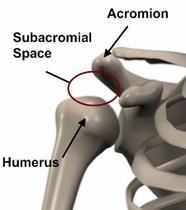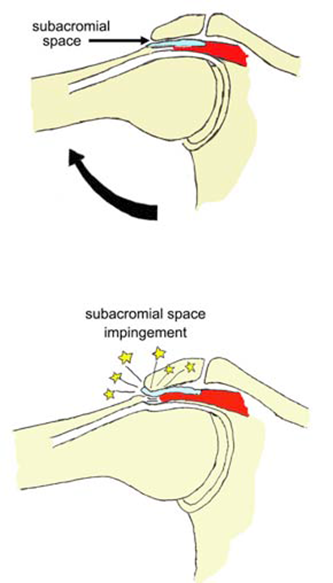Subacromial Space
The space directly beneath the acromion (and directly above the Shoulder Joint) is called the Subacromial Space, and packed into that space are a group of important structures:
1) The Tendon of the long head of the Biceps Muscle
2) The Subacromial Bursa
3) The Rotator Cuff


Raising the arm = Closing the space
The problem we humans have is that as our arm is lifted, the humeral head and acromion draw near each other, narrowing the Subacromial Space. In a healthy Shoulder, the Subacromial Space never gets narrow enough to pinch the structures in it between the Shoulder Joint and the acromion.
But, several pathological conditions (poor Shoulder posture, growth of bone spurs on the underside of the acromion and trauma/ inflammation/swelling of the cuff, biceps or bursa) can narrow the Subacromial Space and lead to the pinching phenomenon called Subacromial Impingement.
Impingement is typically worse in the positions of the Shoulder that close the Subacromial Space most (raising the arm overhead, for instance).
Biomechanics of Throwing:
The Shoulder is most prone to get injured whilst throwing. For better understanding the throwing process, we will divide the motion into five phases:
- Wind-up
- Cocking
- Acceleration
- Release and Deceleration
- Follow-through.

Wind-up:
This phase always precedes cocking when throwing any object, but the effect on injuries is insignificant. Proper execution of the Wind-up, however, is essential for an efficient throwing performance.
Cocking:
This phase does not contribute significantly to injuries either. But correct cocking positions the body for maximum throwing performance. In this phase, maximum tension is applied to all the muscles used in acceleration. The Cocking Motion should be a smooth, well-controlled process of advancing the Shoulder and chest.
Acceleration:
Most throwing-related injuries occur in Acceleration and Deceleration. Correct execution of these phases and proper development of the arm muscles involved improve performance and lessen the chance of injury. In acceleration, the body is brought forward, followed by the arm in a “Whipping Motion''. The Shoulder is subjected to tremendous forces and stress, which must be offset by the muscles responsible for Decelerating Movement. If these muscles are weak or fatigued, the Shoulder Joint becomes unstable which can cause damage.
At greater risk during acceleration is the elbow, where overuse syndromes such as tendonitis and strains occur. The high rate of forearm extension also causes more serious injuries, such as cartilage damage, degeneration and spurs.
Release and Deceleration:
At the moment the ball is released, it has been accelerated to maximum velocity. The Shoulder Muscles responsible for stabilizing the joint are placed under tremendous stress. The elbow is also at risk in this phase.
Follow-through:
This phase allows the body to make a smooth recovery from the severe deceleration forces, reducing forces on the Shoulder and tension on the Rotator Cuff. Understanding of these throwing phases should help a ball player apply his or her knowledge to lessen the chance of injury and improve the performance.
